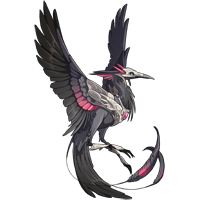

Voyager
(#15447390)
Level 1 Pearlcatcher
Click or tap to view this dragon in Predict Morphology.
Energy: 50/50

Expand the dragon details section.
Collapse the dragon details section.
Personal Style
Apparel
Skin

Scene
Measurements
Length
5.03 m
Wingspan
4.46 m
Weight
697.07 kg
Genetics
Grey
Crystal
Crystal
Silver
Facet
Facet
Obsidian
Circuit
Circuit
Hatchday
Breed
Eye Type
Level 1 Pearlcatcher
EXP: 0 / 245


STR
7
AGI
6
DEF
8
QCK
5
INT
5
VIT
8
MND
6
Lineage
Parents
Offspring
- Molten
- Nozdormu
- Berlast
- Sputnik
- Enterprise
- Tauonic
- Hunger
- HiVolt
- Chromagia
- Thermomagnetic
- Graphite
- Titan
- Sycorax
- Amarna
- Icarus
- Genexus
- Gemstar
- Tycho
- Silas
- Radish
- Sholl
- Jillia
- Ultron
- Unnamed
- Oin
- Pipit
- Adam
- Shibuya
- Zap
- Unnamed
- Tyres
- Kronos
- Hephaestus
- Augustin
- Ansgar
- BlackStar
- ProtoBetaY
- Forge
- Swordsinger
- TemplateZeta
- ShadowMirror
- Miya
- King
- Neriya
- Metalica
- Ophelia
- Krys
- Diamant
- Ineluki
- Crystalline
- Swiftstrike
- Lartessa
- Silverbow
- Rot
- Isolt
- Miserere
- ZERO
- Snowpoff
- BabyHanis
- Fermin
- Arastina
- Ulomog
Biography
Voyager 1

Voyager 1 is a space probe launched by NASA on September 5, 1977, to study the outer Solar System. Operating for 37 years, 11 months and 2 days the spacecraft still communicates with the Deep Space Network to receive routine commands and return data. At a distance of about 131.982 AU (1.974×1010 km; 0.002087 ly), it is the farthest spacecraft from Earth.
The primary mission ended on November 20, 1980, after Voyager passed through the Jovian system in 1979 and the Saturnian system in 1980. It was the first probe to provide detailed images of the two planets and their moons. It also studied the weather, magnetic fields, and rings of those planets and used their gravity to gain speed.
As part of the Voyager program, like its sister craft Voyager 2, the spacecraft is in an extended mission to locate and study the regions and boundaries of the outer heliosphere, and to begin exploring the interstellar medium. Voyager 1 crossed the heliopause and entered interstellar space on August 25, 2012, making it the first spacecraft to do so. Two years later, Voyager 1 began experiencing a third "tsunami wave" of coronal mass ejections from the Sun, that has continued to at least December 15, 2014, further confirming that the probe is indeed in interstellar space. Voyager 1's mission is expected to continue until around 2025, when its radioisotope thermoelectric generators will no longer supply enough electric power to operate any of its scientific instruments.

Voyager 1 is a space probe launched by NASA on September 5, 1977, to study the outer Solar System. Operating for 37 years, 11 months and 2 days the spacecraft still communicates with the Deep Space Network to receive routine commands and return data. At a distance of about 131.982 AU (1.974×1010 km; 0.002087 ly), it is the farthest spacecraft from Earth.
The primary mission ended on November 20, 1980, after Voyager passed through the Jovian system in 1979 and the Saturnian system in 1980. It was the first probe to provide detailed images of the two planets and their moons. It also studied the weather, magnetic fields, and rings of those planets and used their gravity to gain speed.
As part of the Voyager program, like its sister craft Voyager 2, the spacecraft is in an extended mission to locate and study the regions and boundaries of the outer heliosphere, and to begin exploring the interstellar medium. Voyager 1 crossed the heliopause and entered interstellar space on August 25, 2012, making it the first spacecraft to do so. Two years later, Voyager 1 began experiencing a third "tsunami wave" of coronal mass ejections from the Sun, that has continued to at least December 15, 2014, further confirming that the probe is indeed in interstellar space. Voyager 1's mission is expected to continue until around 2025, when its radioisotope thermoelectric generators will no longer supply enough electric power to operate any of its scientific instruments.
Click or tap a food type to individually feed this dragon only. The other dragons in your lair will not have their energy replenished.
Insect stocks are currently depleted.
This dragon doesn't eat Meat.
This dragon doesn't eat Seafood.
Feed this dragon Plants.
Exalting Voyager to the service of the Gladekeeper will remove them from your lair forever. They will leave behind a small sum of riches that they have accumulated. This action is irreversible.
Do you wish to continue?
- Names must be longer than 2 characters.
- Names must be no longer than 16 characters.
- Names can only contain letters.
- Names must be no longer than 16 characters.
- Names can only contain letters.











